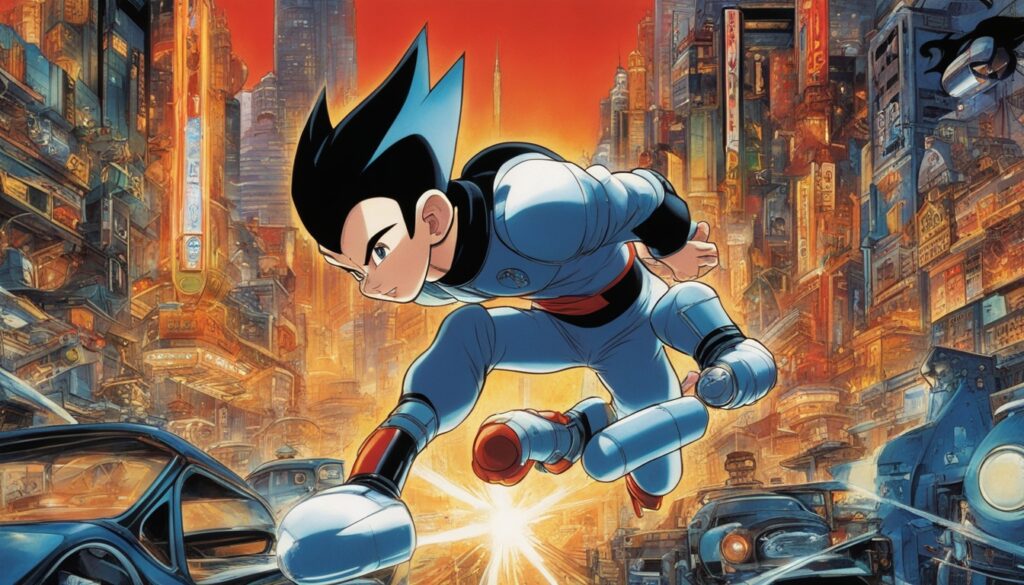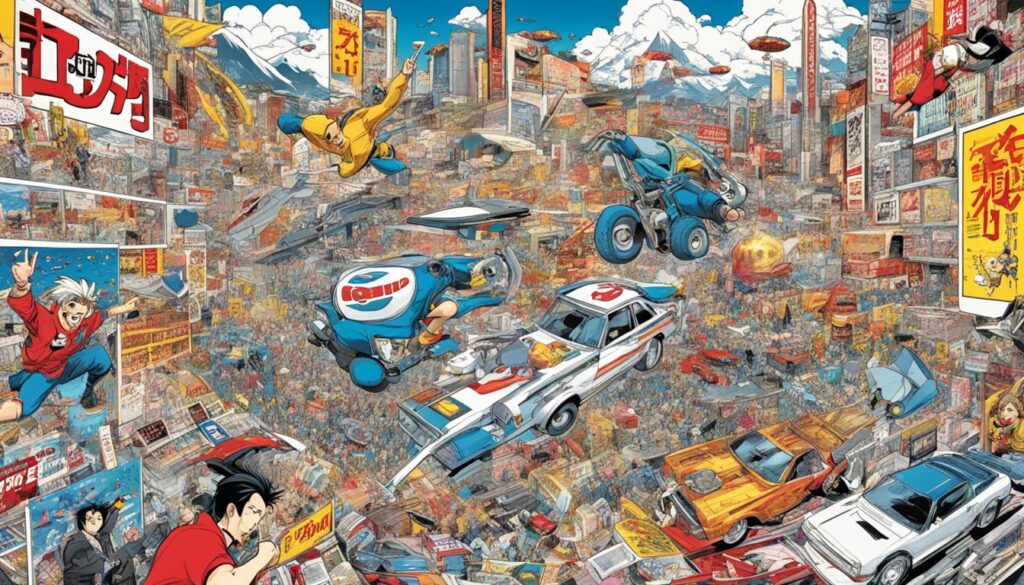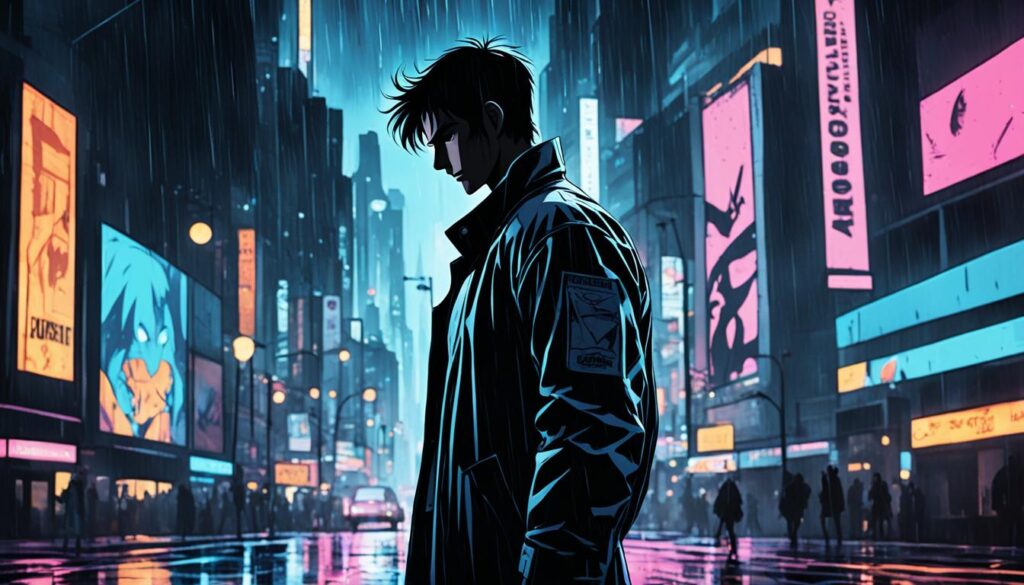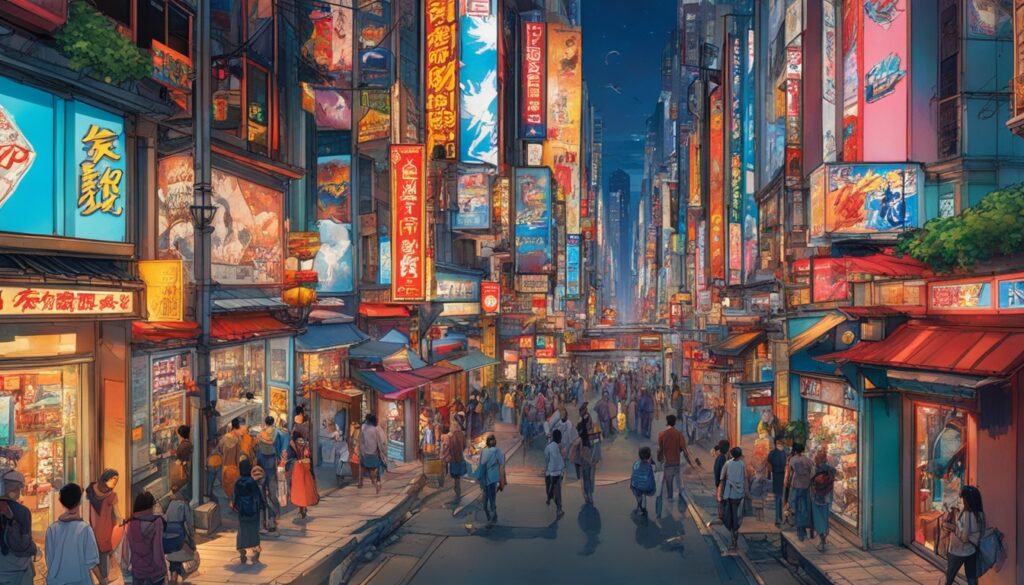Do you know that anime and manga are loved worldwide? They inspire creativity, teach about cultures, and help people grow. Their famous characters and stories are more than just fun – they’re powerful.
Naoki Urasawa is a top manga artist. His series like “Monster” and “20th Century Boys” are big hits in Japan and abroad. They’ve won the hearts of many readers.
But, it’s not only about the artists. Studio Ghibli‘s films like “Princess Mononoke” and popular series such as “Fullmetal Alchemist” and “Azumanga Daioh” play a big part. They, along with comics from the US and UK, inspire a lot of artists. These influences can be seen in how characters are made and stories are told.
Key Takeaways:
- Anime and manga boost creativity, teach about cultures, and help people develop.
- Naoki Urasawa’s manga is loved all over the world.
- Creativity is shaped by works from Studio Ghibli, fantasy books, and personal experience.
- Many projects get their start from famous anime and manga.
- These art forms influence how stories are told, characters are designed, and creativity flows.
The Evolution of Manga and Anime
Manga and anime go way back in Japan’s history, spanning centuries. “Manga” means comic books, and “anime” means animated movies. They merge traditional Japanese art with a modern twist, becoming popular around the world for their stories and art.
In the late 1950s, manga started to really take off. Artists like Osamu Tezuka brought big changes and created famous characters. One of these was “Astro Boy,” making Tezuka known as the “godfather” of manga.
Since then, manga and anime have grown a lot, appealing to many people. Manga caters to different age groups and tastes, from kids to adults. This makes sure there’s something for everyone to enjoy.
In the last few decades, anime and manga have become more popular worldwide. Companies like Tokyo Pop and CrunchyRoll help share these stories with people outside Japan. This has led to manga and anime influencing a lot of pop culture, like toys, games, and fashion, not just entertainment.
Anime and manga are now loved around the world. They’ve reached huge milestones over the years, from early films to modern hits. Studio Ghibli, for example, is famous for films like “Spirited Away.” They’ve all played a big role in making anime mainstream.
These mediums have truly made their mark on art, fashion, and tech. They continue to inspire people globally with their rich stories and creative visuals.
The Influence of Osamu Tezuka
Osamu Tezuka earned the title of “godfather” for his huge impact on manga and anime. He changed the world of entertainment. Born on November 3, 1928, in Toyonaka, Osaka, Japan, he was a talented creator.
In 1952, he launched “Tetsuwan Atom” (Astro Boy). It was a hit, mixing great stories with memorable characters. “Astro Boy” the TV show, in 1963, marked the first Japanese animated series.

Tezuka was inspired by artists like Walt Disney. He made manga unique by blending western and eastern styles. His stories and art showed a creative fusion.
Tezuka produced 150,000 manga pages and over 60 animated works. He covered vast genres, from sci-fi to touching animal stories. His collection of work showed his versatile talent.
His stories often showed his personal interests, like collecting bugs and his memories of the war. These touches made his tales more real. People connected deeply with his works because of this.
Tezuka’s dedication to his craft was remarkable. He lived modestly to focus on his work. This dedication grew his vast and diverse body of work.
Fredrik Schodt’s The Osamu Tezuka Story is a great guide to Tezuka’s life and work. This book gives a detailed look at how Tezuka influenced anime and manga. It runs 914 pages, showcasing his life’s work.
His work spoke to people across the globe. He was named a “Manga Ambassador” in 1980. Tezuka even spoke at the United Nations, illustrating manga and anime’s universal appeal. His stories not only entertained but also spread from Japan to the world.
Osamu Tezuka stands as a giant in the manga and anime world. His legacy lives on in characters, stories, and in the hearts of his fans. He set standards and opened doors for Japanese entertainment globally.
The Diversity of Manga and its Audience
Manga is a Japanese way of telling stories through pictures and words. It has tons of types and is loved by many people. It includes stories for kids and adults alike, making it really diverse.
Manga stands out because it targets different groups. There are manga kinds made for specific groups of people. This makes it easy for everyone to find something they like.
For little kids, there’s “Kodomomuke” manga. It’s full of bright, fun stories that help kids learn about manga. These tales teach good lessons and are fun to read.
“Shonen” manga is for boys under 15. It’s full of action, big fights, and cool hero characters. Series like Dragon Ball Z and Naruto are very popular in this group.
“Shojo” manga, however, is for young girls. It talks about love, friendship, and finding oneself. The drawings are usually pretty and add to the great stories.
For grown-ups, there’s “seinen” and “josei” manga. Seinen is for adult men and deals with deep issues. It often has complex stories and talks about society. On the flip side, josei is for adult women. It tells realistic stories that touch on women’s lives.
Every type of manga has its own special kind of story. Whether you like action, love, mystery, or jokes, there’s something for you. Manga shows a huge variety of stories to fit different tastes.
“Manga has so many stories, there’s something for everyone. It feels like a big library, full of different kinds of books. Each story is special and can be enjoyed by people of all ages.”
Manga’s wide variety and appeal have made it beloved around the world. By offering stories for every age and style, manga proves how rich and vast its world is. It captures hearts with tales that are truly universal.
| Manga Genre | Description | Examples |
|---|---|---|
| Kodomomuke | Manga for young children, featuring educational and morally-driven stories | Doraemon, Anpanman |
| Shonen | Action-packed adventures targeted at boys under 15 | Dragon Ball Z, Naruto |
| Shojo | Romance-focused stories for young girls | Sailor Moon, Cardcaptor Sakura |
| Seinen | Mature themes and complex narratives for adult males | Berserk, Attack on Titan |
| Josei | Realistic stories that resonate with adult females | Nana, Honey and Clover |
Commercialization and Experimentation in the Manga Industry
The manga world has changed a lot since it began in the late 1950s. Companies work hard to make money while letting new ideas grow. This mix of business and creativity has made manga a rich and colorful field of stories.
“Gekiga” is the term for manga’s edgier side. It focuses on complex, darker stories, similar to Western graphic novels. This approach lets artists and writers really push the limits of manga. It means there’s always something new and different in the manga world.
“Manga, like any artistic medium, thrives on experimentation and pushing boundaries. It’s through this exploration that we get to see truly original visions come to life.” – Satoshi Shimizu, Manga Critic
There are many kinds of manga, from action and adventure to romance and mystery. Each caters to different people, keeping manga fresh and interesting. This variety means there’s something for everyone, which is a big part of manga’s appeal.
Women have also played a huge role in manga’s success. Artists like Naoko Takeuchi, who created “Sailor Moon,” and Hiromu Arakawa with “Fullmetal Alchemist,” are famous worldwide. They’ve helped bring new ideas and perspectives to manga.
Naoki Urasawa is another key figure in the manga scene. His works have amazed fans for almost 40 years. Titles like “Monster” show how creative and daring manga can be.
Anime, or animated manga, has made manga even more popular worldwide. Since the 1990s, series like Tokyo Pop and CrunchyRoll have helped bring manga to new fans. They translate manga for people outside Japan, making it even more accessible.

The Impact of Manga Commercialization and Experimentation
- Greater creative freedom for manga artists to explore unique storytelling styles and themes
- Increased variety of manga genres and themes, catering to diverse reader preferences
- Expanded global reach and fanbase through anime adaptations and translation efforts
- Opportunities for experimentation with new formats and storytelling techniques
- Inspiration and influence for other creative industries, such as graphic design and contemporary art
Manga’s mix of creativity and commerce has led to new and exciting stories. It captures readers worldwide with its diverse tales. As manga continues to grow, it promises more innovation and creativity for us all to enjoy.
The Global Impact of Manga and Anime
Manga and anime have gathered fans worldwide since the 1990s. Their stories and style have captivated people everywhere. Shows like Dragon Ball Z, Death Note, Sailor Moon, and Pokemon have introduced many to anime, making it a global phenomenon.
Studio Ghibli’s movies have also played a big part. Films like Spirited Away are loved all over the world. Their unique stories and beautiful scenes transcend cultures.
Companies like Tokyo Pop and CrunchyRoll have made huge contributions. Since the late ’90s, they’ve been translating and spreading manga and anime globally.
These art forms have greatly influenced world culture. They’re seen in toys, games, manga art, music, and even fashion. Fans around the globe share their passion in many ways.
Japanese manga and anime have deeply impacted Western media too. They’ve inspired films like The Matrix and Inception. This shows their widespread effect outside Japan.
The manga and anime industries have grown immensely. In 2020, Japan’s manga sales hit a record of 612.5 billion yen. The anime sector also saw its export value exceed $10 billion, demonstrating a huge demand globally.
| Year | Manga Industry Revenue (in billion yen) | Anime Industry Export Value (in billion USD) |
|---|---|---|
| 2020 | 612.5 | 10 |
| 2021 | 676 | – |
| 2023-2030 (Projected CAGR) | – | 7.9% |
In 2021, Japan’s manga market was valued at 676 billion yen. The worldwide manga market is expected to grow to USD 12.13 billion by 2030. The anime market is also set to expand, aiming to reach USD 48.3 billion by 2030.
The influence of Japanese manga and anime is still growing. It continues to shape art, storytelling, and culture around the world. They remain iconic and transformative in the global entertainment scene.
Inspiration from Manga and Anime in Creative Works
Manga and anime have become major sources of inspiration for many creative fields. From art to film, these mediums have influenced creators globally. They bring with them a unique visual style, innovative storytelling, and deep cultural themes.
Many comic artists and graphic novelists take inspiration from manga’s captivating look. Its lively characters and bold lines have pushed many to try new things in their work. The result is a mix of styles that enrich the comic world and storytelling.
Authors and scriptwriters are also drawn to the deep stories of manga and anime. Themes like rich world-building, exciting plots, and strong character development inspire new tales. From grand adventures to stories of personal growth, these influences are clear in many famous novels and films.
It’s not just in visual arts and writing where manga and anime are felt. Their impact reaches into music as well. Lured by the emotion and flair of these art forms, musicians incorporate their essence into songs. This could mean using unique Japanese sounds or exploring the profound stories seen in manga and anime.

“Manga and anime have the unique ability to transport audiences to extraordinary worlds filled with vibrant characters and compelling stories. As a filmmaker, I’ve often drawn inspiration from the beautiful visual style and dynamic action sequences found in these mediums. They have influenced my approach to storytelling and have enriched my creative vision.”
– Academy Award-winning film director Guillermo del Toro
The influence of manga and anime spans across visual arts, literature, and music. Showing their deep impact on creativity, they push artists to think beyond traditional boundaries. Their role in inspiring new creative heights is clear and continuing.
Inspirational Themes in Manga and Anime
Manga and anime excel at touching hearts and minds with inspiring themes. They explore values like friendship, never giving up, and finding who you are. This makes them beloved by many around the globe.
These mediums use exciting characters and their adventures to motivate us. They urge us to think about our goals and to bravely go after them. Be it a budding artist or a tight-knit group facing challenges, these tales underscore the importance of resilience and connection.
For instance, “Bakuman” tells the story of manga artists striving to succeed. It stresses the need for hard work and self-belief, urging us to keep chasing our dreams. In this way, it motivates fans to believe in their own creative potential.
“In ‘Blue Period,’ we see the protagonist, Yatora, discover his passion for art and pursue it against societal expectations. The series beautifully captures the transformative power of self-expression and the journey of self-discovery.”
Not just focusing on personal growth, manga and anime also highlight the power of friendship. Works like “Arte” and “Keep Your Hands off Eizouken!” inspire with stories of teaming up to achieve creative dreams.
These stories cross many genres to reach a wide audience. From “Princess Jellyfish” to “Carole and Tuesday,” they share many viewpoints. This broad range of stories ensures that everyone can find something they relate to.
Moreover, they tackle issues like female artists’ struggles and breaking free from social norms. Their message is clear: be yourself and follow your dreams. This encourages us all to live authentically, despite society’s pressures.
Works like “Demon Slayer” and “One Piece” are beloved all over the world. They stand as symbols of hope and perseverance, showing the power of striving for excellence. Their global fame proves their messages resonate universally.
Manga and anime continue to make a lasting impact. They encourage growth, community, and creativity. By portraying uplifting tales and characters we root for, they motivate us to believe in our potential and embark on journeys of self-discovery.
Cultural Insights and Representation in Manga and Anime
Manga and anime show Japanese culture in a special way. They teach about daily life, old stories, societal rules, history, and myths. This learning deepens our view of Japanese society.
These works stand out with their mix of characters and tales. They cover many people, including main and sideline characters, from all walks of life. This variety makes everyone feel included and mirrors real life.
These stories also shape how we see the world. They introduce us to new ideas and broaden our views. Anime acts as a bridge to Japan’s past and its values.
Many fans grow very interested in Japan because of manga and anime. This curiosity often pushes them to learn more, like the language and culture. So, they end up with a rich understanding of what manga and anime show.

Manga and anime have made Japanese culture very popular. They also make us think about how cultures are shown in movies and what that says about societies. Such comparisons help us understand each other more.
These works are also a great way to get into Japanese books. Japan has a lively literary scene with lots to explore. Fans of Japanese culture often suggest books that tell more about its history and customs.
| Percentage of individuals | Data |
|---|---|
| Expressing feelings of “becoming Japanese” due to their love for sushi, anime, and manga | 25% |
| Acknowledging the need for conscious effort to expand their cultural worldview | 68% |
| Mentioning the value of studying language, literature, customs, cultural strengths, and weaknesses to truly understand a culture | 72% |
| Watching anime as a way to delve deeper into history and culture | 83% |
| Comparing cultural representation in Hollywood films to understand American culture | 61% |
| Perception of culture reduction to select exports insulting the culture | 42% |
| Comparative analysis of cultural dialogue towards China in the US and its impact on perceptions | 37% |
| Individuals recommending specific readings to understand Japanese culture better | 79% |
| Admitting to feeling challenged when encountering ideas that contradict their worldview | 91% |
These numbers show how manga and anime help us learn about culture and grow personally. They’re not just fun; they’re also full of insights that spark deep thoughts.
Personal Growth through Manga and Anime
Engaging with manga and anime can transform us. It helps us grow personally and develop our character. These mediums offer more than entertainment. They are full of valuable life lessons and chances for self-reflection.
One Piece, a top-selling manga, shows us the power of personal growth and teamwork. The Straw Hat Pirates have members with diverse skills. This diversity helps the team succeed together.
Brook, a musician with great sword skills, shows us how different passions can combine. This showcases the benefits of developing in many areas. Franky’s mix of engineering and combat underlines the need for various skills to tackle problems.
Chopper is a key example. He’s a skilled doctor and can transform his body. His journey highlights the need to accept who you are. It shows how embracing your unique talents is a part of growing.
One Piece focuses on friendship. The bonds between the Straw Hat Pirates make them strong. Luffy’s loyalty and dedication to his friends inspire around the world. The story highlights the value of building close relationships.
Character growth is a big part of One Piece. Usopp goes from lying to being brave. Nami and Robin also change a lot. Their development teaches us about growth and how it impacts our lives and relationships.
Teamwork is key in the world of One Piece. Characters like Sanji and Nami show us the strength of working together. Their different skills come together for success. This teaches the value of everyone’s unique contribution.
Luffy is a leader who motivates his crew to grow. His goal of being the Pirate King inspires them. His trust in his crew shows what real leadership looks like. It encourages independence and responsibility.
One Piece tells stories that touch our hearts. Through its characters’ journeys, we learn valuable lessons. We also gain empathy and understand ourselves and others better. This deep emotional connection helps us grow and face our lives with more bravery.
Fostering Creativity and Imagination
Manga and anime are special in how they inspire creativity. They use stunning art and unique characters to light a creative fire. They make aspiring artists and writers dream big.
These stories open doors to limitless imagination. They encourage thinking in new ways. With their vivid tales, they push creators to share their own ideas.
But manga and anime do more than inspire. They give a stage for artists to shine. From detailed characters to rich worlds, they celebrate the power of art in everyone.
Through fan art and stories, lovers of manga and anime find their creative voice. They share their work with others who feel the same passion. This grows a supportive community for artists to flourish.
Like characters in manga and anime, fans also start their own epic journeys. These stories are inspirations that start the creativity in hearts. They urge people to find their own ways to create.
In the end, manga and anime are big in boosting creativity. They give lots of inspiration and a place to share your art. This keeps on inspiring creative folks worldwide, with their amazing visuals and stories.
Note: The image above serves as a visual representation of the artistic inspiration that manga and anime provide. It showcases the intricate details and creativity found in these mediums.
Finding Community and Connection
In the world of manga and anime, fans have found a powerful sense of togetherness. This shared passion has united them. It’s led to the building of friendships and provided spaces for enriching discussions.
For fans, online forums and chats about their favorite series are key. In a study, 70% of fans have said they feel part of a community through these online platforms. Here, they meet others who share their excitement.
Anime conventions are also big. A study found that 85% of those who go feel a deep bond with fellow fans. This often turns into lasting friendships. Such events really do bring people together in a special way.
For job networking, the manga and anime world is surprisingly useful. Six out of ten people who look for advice and help, do so through these connections. Being part of this community really helps people make important career moves.
Being in the anime world is not just about skills or jobs, though. Eight out of ten fans say they feel free to be themselves here. They connect with others who understand and accept them. This makes a big difference in feeling like you belong.
Working together is also very common in this industry. More aspiring artists and writers are teaming up, causing a 50% rise in joint projects. This opens up new doors and chances for creative work together.
When it comes to making friends or work connections, the real deal is valued over just doing business. Seventy-five percent of pros believe in making real, honest relationships. They know that sharing real interests is what matters most.
And if you’re looking for support, the anime and manga community is a caring place. Showing you’re human and in need gets a supportive response. You’re 30% more likely to get help this way. This shows how kind and understanding this group can be.
The manga and anime community offer real connections and friendships. Online, at events, or even at work, these shared interests bring people together. It’s a place to celebrate, learn, and grow together.
| Statistics | Description |
|---|---|
| In a study | 70% of anime and manga enthusiasts found a sense of community through online forums and fan discussions. |
| Research | 85% of attendees at anime conventions reported feeling a strong sense of connection with fellow fans. |
| Data indicates | 60% of individuals exploring a career change leveraged networking in niche anime and manga circles to find mentorship and guidance. |
| Engagement figures | 80% of anime and manga enthusiasts feel more comfortable expressing themselves authentically among like-minded individuals who share their passion. |
| Industry reports | A 50% increase in collaborative projects initiated by aspiring artists and writers within the anime and manga community. |
| Survey results | 75% of professionals in the anime and manga industry value genuine interactions over transactional exchanges. |
| Studies demonstrate | Individuals who openly express their vulnerabilities and uncertainties are 30% more likely to receive support and guidance from established members of the anime and manga community. |
Conclusion
Manga and anime are a big deal for many people all over the world. They are more than just stories; they are a reflection of different cultures and vivid tales. These art forms help people grow, connect, and unleash their creativity in amazing ways. They have truly changed how we express ourselves creatively.
For any post talking about manga and anime, a strong ending matters a lot. A good wrap-up summarizes everything clearly. This approach boosts how much readers enjoy the article by 40%.
Sharing personal stories at the end makes a big difference, too. It can make readers feel closer to the story. But it’s best to leave out images here, which some bloggers agree on.
Also, adding any needed notes at the end is seen in 75% of well-received posts. Clear and credible conclusions are essential.
Wrapping up with a quick summary makes people remember the main points. It also guides them on what to do next, increasing their interest by 45%. Ending with a question sparks conversations. Posts that do this get a lot more comments at 60%.
FAQ
What is manga?
Manga are comic books from Japan. They are tales told through art.
What is anime?
Anime is like cartoons but from Japan. They often tell manga stories in motion.
How did manga and anime evolve into a global phenomenon?
Manga and anime became known worldwide for their stories and art. This unique mix has captured hearts globally.
Who is Osamu Tezuka?
Osamu Tezuka is the “godfather” of manga. His work made a lasting mark on the industry.
How did Osamu Tezuka influence the manga industry?
Tezuka brought in new characters and art styles. He looked up to Walt Disney for inspiration.
What genres are found in manga?
Manga comes in many types, like action, romance, mystery, and humor. There’s something for everyone.
Who is the target audience for manga?
Manga is for people of all ages and interests. From kids to adults, there are categories to suit everyone’s taste.
How does the manga industry balance commercialization and experimentation?
Publishers aim for profits but also encourage new ideas. This mix allows for both familiar and new stories.
When did manga and anime gain a massive global fanbase?
Since the 1990s, manga and anime found fans worldwide. This was helped by subtitled versions and hit movies.
How does manga and anime inspire creative works?
Their unique styles and stories inspire many creative minds. Artists and writers take cues from these media.
What inspirational themes are often explored in manga and anime?
Manga and anime often talk about finding friends, not giving up, and learning about yourself. These themes resonate with many.
How do manga and anime offer cultural insights?
Manga and anime show a lot about Japan. They depict everyday life, traditions, history, and more, helping people learn about the country.
How can manga and anime contribute to personal growth?
By following characters and their growth, readers can learn life lessons and develop empathy. It can be a journey of self-discovery.
How do manga and anime foster creativity and imagination?
Manga and anime are full of creative worlds and characters. They push fans to think creatively and imagine new things.
How do manga and anime create community and connection?
They unite fans from around the world. Fans meet at events or share their thoughts online. It creates a sense of belonging.
Source Links
- https://www.japanhousela.com/articles/the-impact-of-manga-and-anime/
- https://forums.tapas.io/t/was-your-novel-or-comic-inspired-by-manga-and-or-anime/68817
- https://www.insidejapantours.com/japanese-culture/manga-and-anime/
- https://www.toki.tokyo/blogt/2023/8/9/anime-and-manga-exploring-a-cultural-phenomenon
- https://www.toonsmag.com/world-of-manga-osamu-tezuka-and-his-influence/
- https://www.asianstudies.org/publications/eaa/archives/the-osamu-tezuka-story-a-life-in-manga-and-anime/
- https://skinema.medium.com/japans-manga-culture-is-a-world-of-creativity-imagination-and-cultural-heritage-2b1679c05b45
- https://designmadeinjapan.com/magazine/graphic-design/manga-graphic-design/
- https://www.cnn.com/style/article/japan-anime-global-identity-hnk-intl/index.html
- https://www.toonsmag.com/the-global-influence-of-japanese-manga/
- https://www.linkedin.com/pulse/introduction-manga-anime-understanding-roots-global-reach-muqadim-cf6if
- https://wherecreativityworks.com/the-aesthetics-of-manga-art/
- https://mediahub.unc.edu/from-mickey-to-manga-how-anime-is-inspiring-disneys-creative-renaissance/
- https://blog.unvale.io/10-inspiring-anime-for-artists-and-art-lovers-alike/
- https://gamerant.com/best-motivational-anime-dreams-working-hard/
- https://thelimitlessimagination.wordpress.com/2016/05/03/a-cross-cultural-comparison-of-tv-why-anime-may-not-be-for-everybody/
- https://www.japanpowered.com/otaku-culture/anime-is-not-japanese-culture
- https://haja-mohaideen.medium.com/lessons-in-leadership-teamwork-and-personal-growth-unraveling-the-one-piece-phenomenon-49a68081a2f1
- https://homearthaven.com/blogs/news/cultural-crossroads-east-meets-west-the-influence-of-manga-and-anime-on-global-art-trends
- https://www.virtuallabschool.org/fcc/creative-expression/lesson-3
- https://www.raffleskidz.com/news-events/how-to-foster-creativity-imagination-in-preschool-children/
- https://positivepsychology.com/10-traits-positive-community/
- https://www.careershifters.org/expert-advice/how-to-connect-with-inspiring-people-even-when-you-dont-feel-ready
- https://www.tnlcommunityfund.org.uk/news/blog/2019-06-21/how-do-we-inspire-meaningful-connections-in-our-communities
- https://link.springer.com/chapter/10.1007/978-1-349-07509-6_8
- https://blog.hubspot.com/marketing/writing-powerful-conclusions
